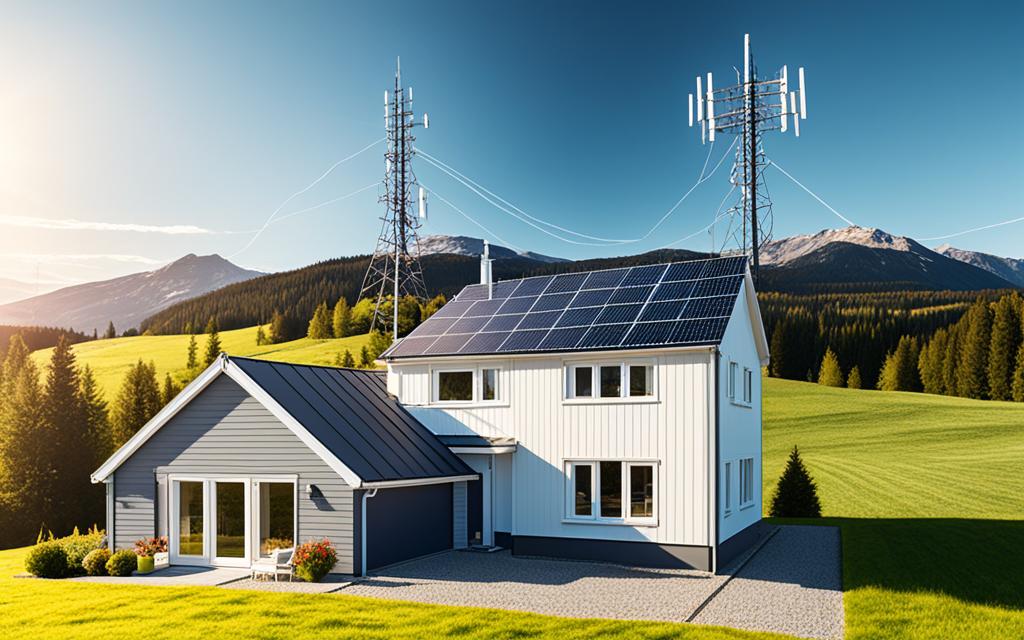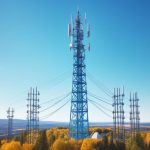Fixed wireless access (FWA) is revolutionizing broadband delivery in rural and low-density areas, providing high-speed broadband internet access through the use of LTE technology. FWA offers a game-changing solution for areas where wired options are limited or unavailable. It allows for affordable and rapid deployment of high-speed internet connections, bringing reliable broadband access to even the most remote regions.
One of the key drivers behind the adoption of FWA is the increasing demand for high-speed broadband internet in rural areas. As more people rely on digital connectivity for work, education, and entertainment, FWA provides a viable solution to bridge the connectivity gap. With lower deployment costs compared to traditional wired technologies, FWA offers a cost-effective and efficient alternative.
FWA networks also provide robust security measures, ensuring the privacy and protection of user data. These networks are highly adaptable and expandable, allowing for seamless integration with existing infrastructure and easy scalability to meet growing connectivity demands.
Technological improvements in LTE technology have further enhanced the capabilities of FWA networks, delivering faster and more reliable transmitted speeds. With government subsidies and support, the deployment of FWA networks is also becoming more widespread, contributing to the increased accessibility of high-speed broadband internet in rural areas.
While FWA faces competition from other connectivity technologies such as cable, DSL, fiber, and satellite, its advantages in terms of lower deployment costs, adaptability, and scalability make it a strong contender. The numbers forecast a promising future for FWA, with a projected global FWA connection of 330 million by the end of the decade. 5G is expected to become the majority of connections, further propelling the growth of FWA networks.
The Advantages of FWA Over Wired Technologies
Fixed wireless access (FWA) offers numerous advantages over traditional wired technologies like cable, DSL, and fiber. Let’s take a closer look at some of these key advantages:
- High-Speed Broadband: FWA provides high-speed broadband internet access, comparable to fiber or cable, ensuring smooth and efficient connectivity for households and businesses.
- Affordability: FWA offers a more affordable option for internet access, making it highly attractive to users seeking cost-effective solutions without compromising on speed and quality.
- Rapid Deployment: With its lower deployment costs, FWA enables quick and efficient implementation. By leveraging existing cellular towers and wireless transmission, FWA networks can be deployed rapidly, connecting users in a shorter timeframe.
- Robust Security: FWA networks inherit the robust security protocols of cellular networks, ensuring a secure and protected connection for users. This feature enhances the trustworthiness and reliability of FWA as a broadband access solution.
- Adaptability: FWA networks are highly adaptable and scalable, allowing businesses and users to expand and customize their service as per evolving requirements. This flexibility ensures that FWA can meet the ever-changing demands of the market.
- Technological Improvements: Technological advancements in wireless networks, particularly with the emergence of 4G and 5G technologies, have significantly enhanced the speed, capacity, and overall performance of FWA. Users can rely on FWA for reliable and high-performance broadband access.
Overall, FWA offers a compelling set of advantages, combining high-speed broadband, affordability, rapid deployment, robust security, adaptability, and advanced wireless technologies. These factors make FWA a reliable and efficient solution for broadband access, catering to the needs of diverse users.
| Advantages of FWA | |
|---|---|
| High-Speed Broadband | Comparable speeds to fiber or cable |
| Affordability | More cost-effective option |
| Rapid Deployment | Lower deployment costs and quick implementation |
| Robust Security | Inherits secure protocols from cellular networks |
| Adaptability | Flexible and scalable to meet evolving requirements |
| Technological Improvements | Enhanced speed, capacity, and performance with 4G and 5G |
FWA vs Other Connectivity Technologies
When comparing Fixed Wireless Access (FWA) to other connectivity technologies, it becomes evident that FWA offers significant advantages over its counterparts. Let’s explore the key differences in terms of speeds, deployment costs, latency, and throughput:
Comparing FWA to Cable and DSL
Cable and Digital Subscriber Line (DSL) technologies require wired infrastructure throughout the entire connection, which limits the speeds and capacities they can provide. In contrast, FWA utilizes wireless transmission, enabling high-speed broadband access without the need for extensive wired infrastructure.
FWA vs Fiber
Fiber technology offers the fastest speeds currently available. However, it comes with high deployment costs, making it less feasible for widespread implementation, especially in rural areas. FWA, on the other hand, provides comparable speeds to fiber at a fraction of the deployment costs, making it a cost-effective alternative.
FWA vs Satellite Services
Satellite services, while serving remote locations, often suffer from higher latency and costlier monthly bills. FWA, with its low-latency wireless transmission, enables real-time applications and high throughput, delivering a more efficient and affordable solution for broadband access.
In summary, FWA outperforms cable, DSL, fiber, and satellite in terms of speeds, deployment costs, latency, and throughput. Its wireless nature allows for rapid deployment, offering high-speed broadband access to areas where wired technologies are limited. FWA’s cost-effectiveness and reliability make it a competitive option in the market.
The Growth and Potential of FWA
Fixed wireless access (FWA) has witnessed remarkable growth in recent years, with a projected 554 operators in 187 countries and territories offering LTE or 5G services. This global expansion demonstrates the increasing adoption and potential of FWA as a reliable broadband solution.
By the end of the decade, global FWA connections are expected to reach a staggering 330 million, with 5G connections becoming the majority. This growth trajectory highlights the significance of FWA in meeting the ever-growing demand for high-speed internet access.
Fully realizing the potential of FWA, its adoption is not limited to rural communities alone but also extends to urban areas. FWA presents a cost-effective deployment option for mobile network operators (MNOs) by leveraging their existing infrastructure and equipment to provide high-speed internet access to both underserved rural regions and congested urban centers.
FWA adoption has been widespread in various regions around the world, including North America, Western Europe, Central and Eastern Europe, the Middle East, and Africa. Its versatility makes it a viable solution for various geographical and economic landscapes.
“FWA offers an excellent opportunity for MNOs to expand their service offerings while capitalizing on their existing cellular infrastructure.”
With increased FWA adoption, governments and regulators have shown keen interest and support by providing funding and implementing policies that promote the expansion of FWA networks. This support further accelerates the growth of FWA and facilitates the delivery of high-speed broadband access to regions previously underserved by traditional wired technologies.

The Benefits of FWA for MNOs
For MNOs, offering FWA services enables them to tap into new revenue streams while maximizing the utilization of their existing cellular infrastructure. By leveraging their tower networks and equipment, MNOs can rapidly deploy FWA services, delivering high-speed internet access to a wide range of customers.
Some key benefits of FWA for MNOs include:
- Cost-effective deployment
- Utilization of existing infrastructure
- Ability to reach underserved areas
- Increased customer base
- Enhanced competitive advantage
These advantages position FWA as an attractive option for MNOs looking to expand their service offerings and meet the growing demand for high-speed broadband internet access.
| Region | FWA Adoption |
|---|---|
| North America | High |
| Western Europe | High |
| Central and Eastern Europe | Medium |
| Middle East | Medium |
| Africa | High |
The table above outlines the regional adoption of FWA, demonstrating its widespread acceptance and potential for growth across various parts of the world. This data further reinforces the optimistic outlook for FWA as a transformative broadband platform.
With ongoing advancements in technology and the continuous push for expanded connectivity, FWA’s growth trajectory is only expected to escalate. The future holds immense potential for FWA to bridge the digital divide, providing enhanced broadband access to previously underserved communities and fueling economic growth.
Conclusion
Fixed wireless access (FWA) has emerged as a transformative broadband platform, perfectly catering to the connectivity demands of both rural regions and urban centers. FWA offers a range of advantages, including rapid deployment, competitive speeds, robust security, and adaptability. In rural areas, where wired infrastructure may be lacking, FWA provides a cost-effective solution for modern broadband access. Conversely, in urban areas, FWA injects healthy competition and much-needed choice for frustrated cable subscribers.
Mobile network operators can tap into the value of their existing cellular infrastructure by unlocking FWA services. This enables them to leverage their assets and offer high-quality broadband access to underserved markets. The key drivers behind FWA adoption, such as ongoing technology improvements, government funding and policies, and market competition, paint a promising picture for FWA’s future.
By leveraging the power of LTE technology, FWA eliminates the need for traditional wired connections, guaranteeing reliable connectivity and uncompromised value. As demands for seamless connectivity continue to surge, FWA stands strong as a transformative broadband platform.
The time for fixed wireless access is now.
FAQ
What is fixed wireless access (FWA)?
Fixed wireless access is an innovative wireless option that delivers high-capacity wireless signals to fixed location receivers, providing high-speed broadband internet access in both rural and low-density areas.
What are the key drivers for adopting FWA?
The key drivers for adopting FWA include increasing demand for high-speed broadband internet, lower deployment costs compared to wired technologies, robust security protocols, adaptability and scalability, and advancements in wireless technologies.
How does FWA compare to other connectivity technologies?
FWA offers significant advantages compared to other connectivity technologies such as cable, DSL, fiber, and satellite. It provides comparable speeds to cable and fiber at a fraction of the deployment costs, with lower latency than satellite services.
What is the projected growth of FWA?
The global number of FWA connections is expected to reach 330 million by the end of the decade, with 5G becoming the majority of connections. FWA adoption is widespread in regions such as North America, Western Europe, Central and Eastern Europe, the Middle East, and Africa.
Can FWA be used in urban areas?
Yes, FWA is not just limited to rural communities but also has applications in urban areas. It presents opportunities for mobile network operators to capitalize on their existing infrastructure by offering FWA services, injecting competition and choice for frustrated cable subscribers.



















